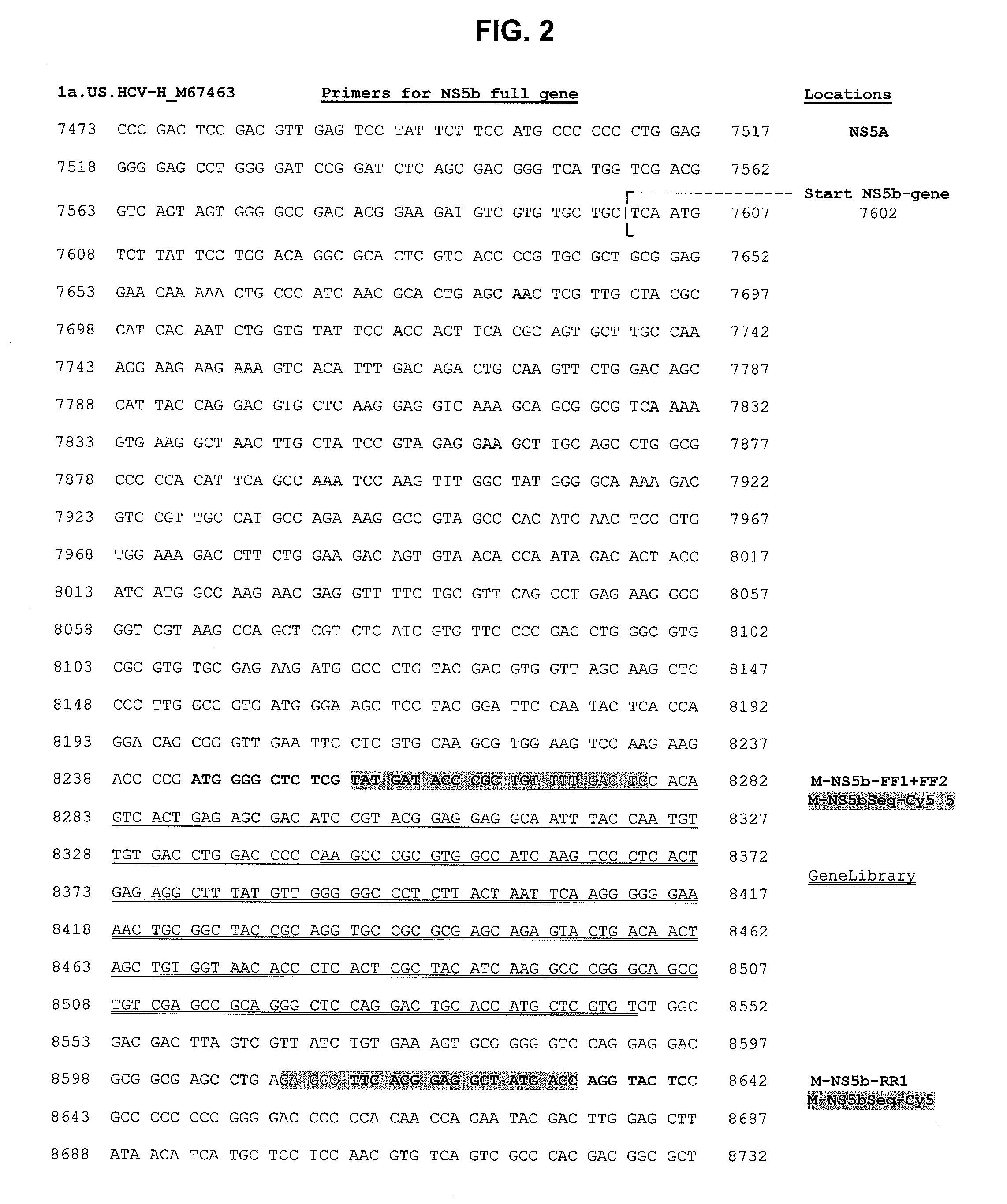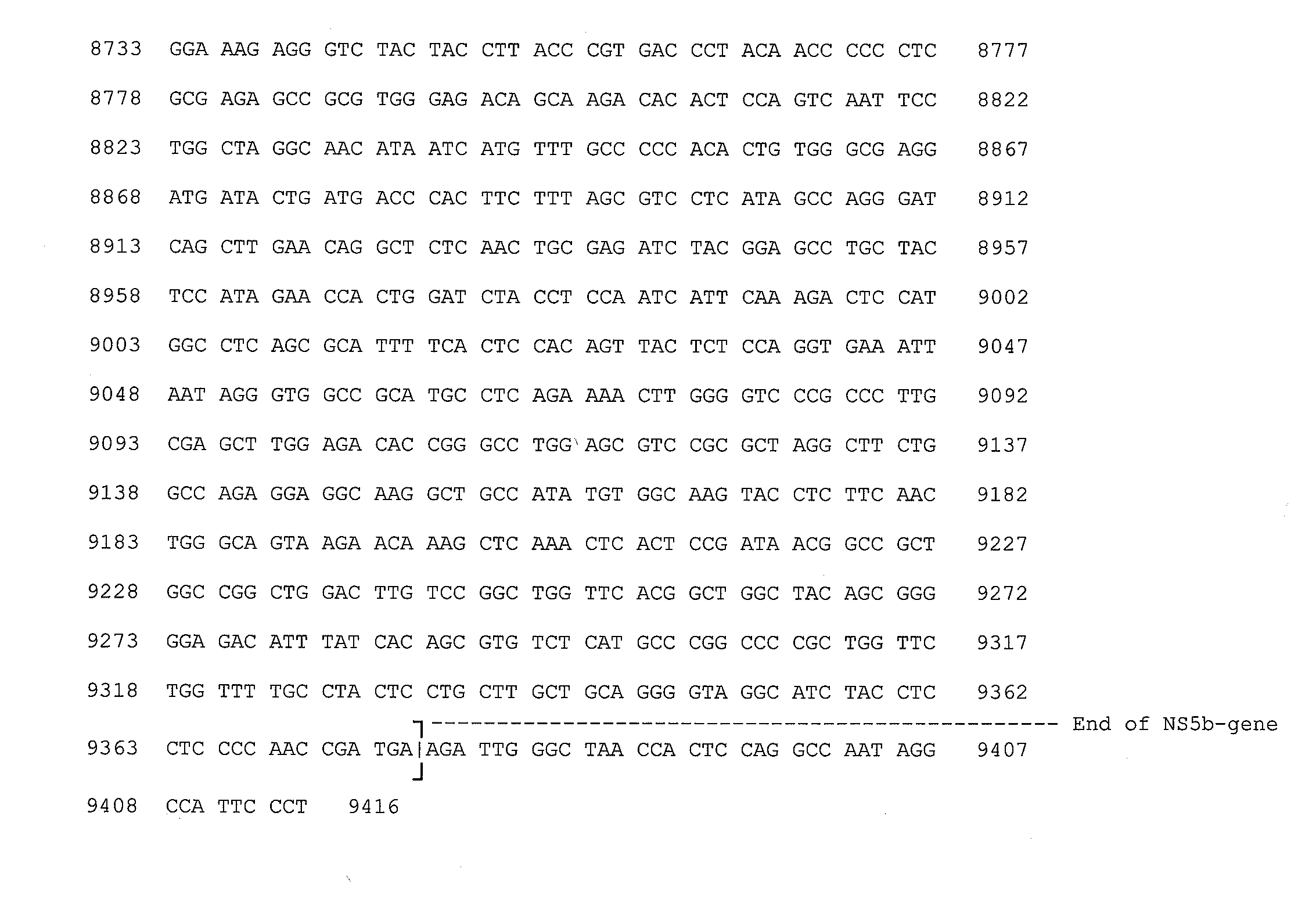Methods and Reagents for Genotyping HCV
a technology of hepatitis c virus and reagents, which is applied in the field of methods and materials for genotyping hcv, can solve the problems of hcv genetic variability, hcv complicates the process of amplification, sequencing and genotyping, and the type of assay is rapid but not as accurate as sequencing-based assays
- Summary
- Abstract
- Description
- Claims
- Application Information
AI Technical Summary
Benefits of technology
Problems solved by technology
Method used
Image
Examples
example 1
HCV NS5b Genotyping by Sequencing
[0101]This following example describes a laboratory protocol to produce bi-directional sequence of a 204 base pair fragment in the NS5b region of Hepatitis C virus for the purpose of determining genotype and subtype.
[0102]Generally, viral HCV RNA is extracted from the plasma sample using a Qiagen QIAamp Viral RNA Mini Kit as described by the manufacturer. Briefly, the extracted RNA specimens are reverse transcribed using random hexamers.
[0103]Following cDNA synthesis, 10 μL of the cDNA template is amplified using specific primers to generate a 398 base pair amplicon.
[0104]Following PCR amplification, a dye-primer CLIP sequencing reaction is performed. The CLIP reaction sequences both strands of the DNA simultaneously by using forward (sense) and reverse (antisense) primers each labeled with different fluorescent dyes (Cy 5.5, Cy 5; chain-extension reagents, and one of four chain-terminating dideoxynucleotide triphosphates (ddNTPs): dideoxyadenosine (...
example 2
Evaluation of Performance Characteristics of HCV NS5b Genotyping By Sequencing
[0125]The performance characteristics of HCV NS5b genotyping assay were evaluated, based on genotyping assays substantially as described above in Example 1, using the following reagents.
HCV NS5b Specific ReagentsDescriptionLot #M-NS5b-FF1Oct. 27, 2004M-NS5b-FF2Dec. 27, 2004M-NS5b-RR1Oct. 27, 2004M-NS5bSes-Cy5.5Oct. 27, 2004M-NS5bSeq-Cy5Oct. 27, 2004
General Purpose Reagent'sDescriptionLot #PCR Buffer IIE1089625 mM MgCl2E10900dNTP 100 mM36227107050Random HexamersF06662RNase InhibitorF07872SuperScript III RT1232439AmpliTaq GoldE11258DMSOR19030SureFill 6% Sequencing Gel0294B94MicroCel 5002624Cy5.5 / 5 Cycle Sequencing Kit containing the01609following:Sequencing BufferThermoSequenase EnzymeThermoSequenase Dilution Buffer
[0126]The following samples were used:
SamplesHCVHCV GenotypeHCV GenotypeGenotypeViral Load(LiPA TMA LiPA)(TRUGENE 5′NC)(NS5B)Specimen ID(c / mL)Vendor1 Acrometrix 1Acrometrix2bAcrometrix 2Acrometrix...
example 3
Evaluation of Performance Characteristics of HCV NS5b Genotyping By Sequencing
[0140]Analytical Accuracy Analysis
[0141]A subset of the phase 1 validation accuracy samples consisting of a 6 member panel comprising genotypes 1-6, a 12 member panel comprising genotypes 4-10, and 4 additional clinical samples comprising genotypes 4, 5 and 6 will be analyzed and results compared to previous genotype. Samples were previously characterized by either LiPA or TruGene 5′NC genotyping or another NS5b method as detailed in the samples section.
Analytical Accuracy DataSample IDExpected GenotypeBRTL NS5b GenotypeHCVGTP-004c #1 7C (6f)6fHCVGTP-004c #2 9B (6i)6iHCVGTP-004c #3 8C (6n)6nHCVGTP-004c #4 6B6bHCVGTP-004c #5 7C (6f)6fHCVGTP-004a #110A (3k)3kHCVGTP-004a #2 8C (6n)6nHCVGTP-004a #310A (3k)3kHCVGTP-004a #4 9B (6i)6i14682 4A4a15038 5A5a20759 6A6aAcrometrix 1 1B1aAcrometrix 2 2B2bAcrometrix 3 3A3aAcrometrix 4 44aAcrometrix 5 5A5aAcrometrix 6 6A6aGP4A-C2 4AUG (no amp) rpt 4a1-5A 5A5aGP6A-A2 6A6aGP...
PUM
| Property | Measurement | Unit |
|---|---|---|
| temperatures | aaaaa | aaaaa |
| width | aaaaa | aaaaa |
| length | aaaaa | aaaaa |
Abstract
Description
Claims
Application Information
 Login to View More
Login to View More - R&D
- Intellectual Property
- Life Sciences
- Materials
- Tech Scout
- Unparalleled Data Quality
- Higher Quality Content
- 60% Fewer Hallucinations
Browse by: Latest US Patents, China's latest patents, Technical Efficacy Thesaurus, Application Domain, Technology Topic, Popular Technical Reports.
© 2025 PatSnap. All rights reserved.Legal|Privacy policy|Modern Slavery Act Transparency Statement|Sitemap|About US| Contact US: help@patsnap.com



